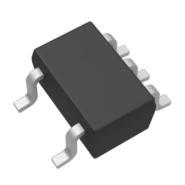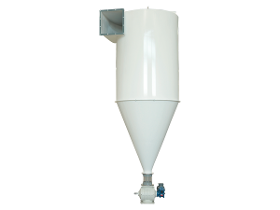dedusting
Cyclone
Description
Force-of-gravity separators, which are used as pre-filters or for the separation of large quantities of dust and swarf. Cyclone separator Cyclones are force-of-gravity separators. The separation principle is based on centrifugal force, which is produced by the tangential injection of the raw air. Cyclones are used as pre-filters or for the separation of large quantities of dust and swarf. The degree of separation of a cyclone is not normally sufficient to meet the usual environmental protection requirements. The cyclone exhaust air must be post-filtered in most cases. Product description A cyclone essentially consists of three parts: the intake cylinder, the cone and the immersion tube. In the intake cylinder, the raw air is brought into a circular path by means of tangential injection. Due to the taper of the subsequent cone, the speed of rotation increases sharply, so that the particles are pressed by centrifugal force against the outer wall and decelerated by friction, causing them to drop out of the air stream and fall down. The cleaned air leaves the cone in an upward direction via the central immersion tube. Cyclones are usually welded sheet steel structures. Cellular wheel sluices or, in individual cases, double-gate sluices are used for the pressureless discharge of the material. In order to increase the cyclone effect, or the degree of separation, counter-spirals with a pipe connection can be placed on top of the immersion tube. Further options are, for example, wearing devices, explosion pressure relief devices, control flaps, level monitoring devices and manufacturing in stainless steel or galvanised sheet steel.
Similar products

PARSMEGA MAKINA
Turkey
It ensures the retention of dust and other light substances in the air coming from the cleaning machines. When the air containing dust coming from the dust aspirator is given tangentially to the cyclone, the dust in the air loses its speed as a result of cross-sectional expansion and falls by gravity, while clean air is discharged. Thus, the environmental impact of the air released outside the factory is minimized.
Request for a quote
LOSBERGER GMBH
Germany
Perfect for: Live communications Catering Hospitality Unique roof design Due to the architecturally sophisticated shape of the building, this mobile space solution stands out at any event. Its clear line, side heights of 2.80m and unique roof design makes the Cyclone a breath of fresh air in the event structures industry. It offers a new appearance from all four points of the compass, whilst inside, a feeling of space in a new dimension is created. Drainage as a design feature The roof is the stand-out design feature of this transparent structure. It’s flat, but tapers downwards like a cyclone with a slight increasing lateral curvature. A lovely design feature, that also functions as drainage. In the event of rain, water will be released into the ground via this revolutionary feature. As with all Losberger De Boer space solutions, the Cyclone can be combined with other structures, to form a complete tent landscape.
Request for a quote
KYNIX SEMICONDUCTOR HONG KONG LIMITED
Hong Kong
Cyclone III Device Family Overview Cyclone® III device family offers a unique combination of high functionality, low power and low cost. Based on Taiwan Semiconductor Manufacturing Company (TSMC) low-power (LP) process technology, silicon optimizations and software features to minimize power consumption, Cyclone III device family provides the ideal solution for your high-volume, low-power, and cost-sensitive applications. To address the unique design needs, Cyclone III device family offers the following two variants: ■ Cyclone III—lowest power, high functionality with the lowest cost ■ Cyclone III LS—lowest power FPGAs with security With densities ranging from about 5,000 to 200,000 logic elements (LEs) and 0.5 Megabits (Mb) to 8 Mb of memory for less than ¼ watt of static power consumption, Cyclone III device family makes it easier for you to meet your power budget. Cyclone III LS devices are the first to implement a suite of security features at the silicon, software
Request for a quoteRequest for quotes
Create one request and get multiple quotes form verified suppliers.
- Only relevant suppliers
- Data privacy compliant
- 100% free
